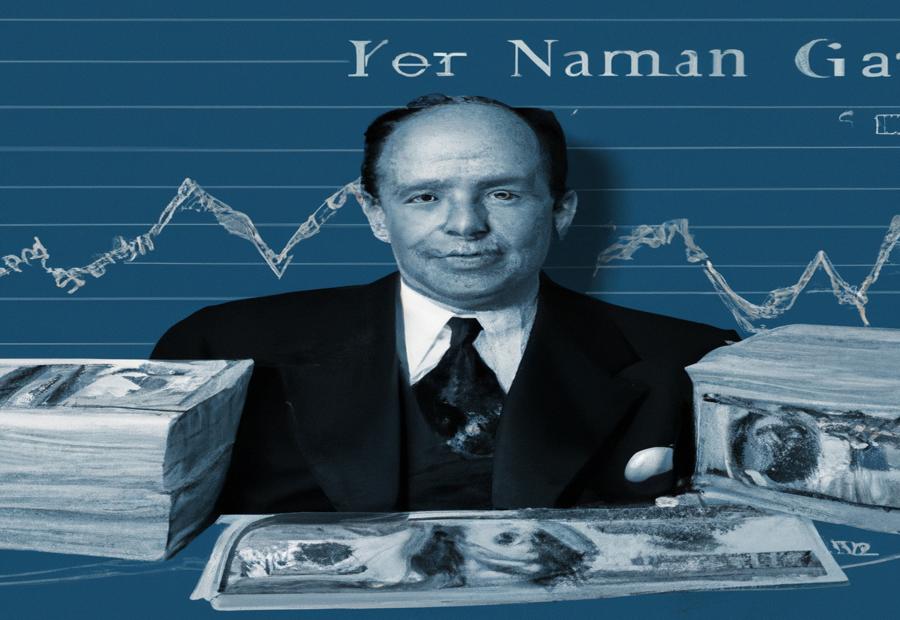Key Takeaways:
- Benjamin Graham is known as the Father of Value Investing.
- Graham’s investment philosophy emphasized value investing, intrinsic value, margin of safety, and diversification.
- Benjamin Graham’s net worth at the time of his death was estimated based on his successful Wall Street career and his approach to alternative investments.
- Graham’s impact on the field of investing is significant, with his principles continuing to be relevant in the twenty-first century, as evidenced by the Graham and Dodd Award.
Introduction
Photo Credits: Ecopolitology.Org by Lawrence Moore
Benjamin Graham, known as the Father of Value Investing, revolutionized the world of finance. In this section, we will explore the remarkable life and accomplishments of this influential figure. Discover how Graham’s innovative investment philosophy shaped the way we approach the stock market and learn about his lasting impact on the field of finance. Get ready to delve into the fascinating journey of Benjamin Graham and uncover the principles that continue to guide investors today.
Variation of the main title: “Benjamin Graham: The Father of Value Investing”
Benjamin Graham, known as the “Father of Value Investing,” is an iconic figure. His investment approach, based on fundamental analysis, still shapes the financial world. He stressed the importance of figuring out an investment’s intrinsic value and investing with a margin of safety. Graham’s work inspired many investors, including Warren Buffett.
His legacy lives on in awards such as the Graham and Dodd Award. This shows how relevant his ideas remain today. From Wall Street to Warren Buffett, Benjamin Graham made a big impact on investing. He’s still called the “Father of Value Investing,” proving he was a pioneer whose methods have influenced many.
Related Post:
Benjamin Graham’s Background and Career
Photo Credits: Ecopolitology.Org by Brandon Campbell
Benjamin Graham’s Background and Career takes us on a journey through the remarkable life of this financial genius. We’ll dive into his early life and education, exploring the pivotal experiences that shaped his investment philosophy. Then, we’ll delve into his transformative Wall Street career and the groundbreaking Graham-Newman Partnership. Lastly, we’ll uncover how Graham’s ideas and teachings influenced none other than the legendary Warren Buffett. Get ready to discover the extraordinary story of Benjamin Graham and his lasting impact on the world of investing.
Early Life and Education
Benjamin Graham had a life and education which were important in making him the Father of Value Investing. Growing up in an academic atmosphere, he was passionate about maths and finance from a young age. He went to Columbia University to do his undergrad degree where he focused on philosophy, economics and maths. On finishing this, he got a master’s degree in business from Columbia Business School. Graham was influenced by David Dodd, a professor at the university, and his book “Security Analysis“. This book was important as it showed the value in looking at intrinsic value rather than market trends; this shaped Graham’s investment philosophy.
At Columbia University, he made connections and was able to get a job at Newburger Henderson & Loeb on Wall Street. This was the start of his successful career and he eventually went into partnership with Jerome Newman to create the Graham-Newman Corporation.
Benjamin Graham didn’t just rely on traditional education though. He was committed to learning more and was involved in various businesses, wrote books on investment theory and tried to learn from real experiences.
In summary, Benjamin Graham’s early life and education gave him the solid base for his future as an investor. The exposure to key concepts at Columbia University gave him the knowledge to practice value investing, with principles like looking at intrinsic value and having a safety margin. His dedication to learning more, through alternative investments and intellectual challenges, showed his commitment to continually developing his knowledge of finance.
Wall Street Career and Graham-Newman Partnership
Benjamin Graham’s Wall Street journey included many significant events. After education, he found success. He created important connections and made great contributions to investment. He and Newman formed the Graham-Newman Corporation. Here, Graham applied his value investing philosophy to stock selection. He analyzed companies and looked for undervalued stocks with a margin of safety.
Graham’s Wall Street career wasn’t only about stocks. He explored other investments too, such as bond arbitrage and special situations. By diversifying his investments, he maximized potential returns and minimized risks.
Overall, Benjamin Graham’s Wall Street career and partnership with Graham-Newman made him the father of value investing. His work impacted many investors, including Warren Buffett. Buffett used Graham’s principles and achieved success in finance. Graham also gave insights into alternative investments like bond arbitrage or special situations – readers can gain knowledge and broaden their understanding by exploring these further. Benjamin Graham’s remarkable success and net worth make his teachings and strategies even more valuable. Warren Buffett owes his success to Benjamin Graham’s profound influence and ability to spot value.
Influence on Warren Buffett
The influence of Benjamin Graham on Warren Buffett is immeasurable. Graham, a veteran investor, was a mentor to Buffett and a huge influence on his investment decisions.
Value investing, a philosophy Graham championed, was adopted by Buffett. It focuses on analyzing stocks based on their intrinsic value, instead of short-term market fluctuations. This resonated with Buffett who believed in buying undervalued stocks and keeping them long-term.
Graham’s ‘margin of safety’ was particularly influential. This concept advocates for investing in companies with a significant gap between market price and intrinsic value – providing a layer of protection against losses. Buffett fully embraced this idea and applied it to his own investment strategy.
Diversification was another principle that Buffett learned from Graham. Although he later changed his strategy to focus on high-conviction investments, Buffett valued the need to spread risk.
The mentor-mentee relationship between Graham and Buffett was invaluable. Graham shared his wisdom and experiences, offering Buffett a valuable source of advice and guidance. This relationship was essential in shaping Buffett’s successful career as a top investor.
Benjamin Graham’s Investment Philosophy
Photo Credits: Ecopolitology.Org by Gary Wright
Benjamin Graham’s investment philosophy delves into the principles of value investing, intrinsic value, margin of safety, diversification, and alternative investments. By understanding Graham’s approach, investors can gain valuable insights into making sound financial decisions and maximizing returns. Let’s explore the key concepts and strategies that shaped Graham’s successful investment philosophy.
Value Investing and Intrinsic Value
Value investing means looking for securities undervalued or trading at a cheaper price than their true value. Benjamin Graham, known as the father of value investing, said it is important to take time to study financial reports and do research before making decisions. He thought buying stocks at a discount to intrinsic value could lead to long-term success in the market.
Graham was a big believer in fundamental analysis. This involves analyzing a firm’s financial health, earnings prospects, and market position. He suggested looking at things like cash flow, balance sheet strength, and competitive advantage when estimating true value. He said by focusing on a company’s foundation, rather than momentary market changes, investors can find ways to make money.
He also introduced margin of safety. This says investors should only invest in securities with a big difference between their price and their intrinsic value. Graham wanted to protect investors against sudden drops in stock prices or bad events that affect the company.
Graham had his eyes on other investments besides stocks and bonds. He believed in diversifying across different asset classes to reduce danger and increase returns. He thought looking into unconventional investments like real estate or distressed assets could be worth it if they offered good opportunities.
Benjamin Graham left a lasting footprint on investing. His teachings are still influential today and have inspired many successful investors, such as Warren Buffett. Value investing and assessing intrinsic value are still important today, as investors try to get long-term success in an ever-changing market.
Margin of Safety and Diversification
Text:
Benjamin Graham’s investment philosophy was revolutionary, centered around the concept of margin of safety and diversification. He focused on buying assets at prices below their true worth, to minimize risk and maximize potential gains.
This approach created a buffer against market volatility and enabled long-term success. Graham also advocated for diversifying investments across different industries and asset classes.
He stressed the importance of research, advocating thorough analysis of financial statements and data to find opportunities where the market price and intrinsic value differ.
The concept of margin of safety and diversification remains highly relevant in modern investing strategies. Warren Buffett and many other successful investors have adopted Graham’s principles. His legacy lies in providing a framework that has withstood the test of time.
Alternative Investments and Graham’s Approach
Text:
Benjamin Graham, a financial guru, revolutionized investment strategies. He found opportunities – beyond stocks and bonds – that could bring substantial returns. Graham’s philosophy: diversification. This differed from the current strategies.
Graham supported alternative investments like real estate, commodities, and private equity. He saw the potential benefits: income, hedging against inflation, and long-term growth. These investments offered a variety of choices to fit financial goals and risk tolerance.
Analysis and valuation were essential to Graham’s approach. He valued assets through research, aligning with value investing principles. This enabled informed decisions and maximum returns.
Graham also stressed the importance of a margin of safety. This conservative approach protected investors by acquiring assets at prices significantly lower than their estimated values.
Initially met with skepticism, Graham’s ideas slowly gained acceptance. Today, numerous investors have incorporated alternative investments into their portfolios. Investors use these to maximize returns and manage risk.
Don’t limit yourself to conventional assets. Explore alternative investments and diversify your holdings. You can stay ahead and achieve success.
In addition to his work on alternative investments, Benjamin Graham also left a lasting legacy. His net worth and financial success demonstrate the effectiveness of his investment philosophy.
Benjamin Graham’s Net Worth
Photo Credits: Ecopolitology.Org by George Anderson
Benjamin Graham’s net worth was impressive, thanks to various factors and his astute investment strategies. In this section, we will explore the estimate of his net worth at the time of his death, the key factors that contributed to his wealth, and how Graham’s generosity and focus on intellectual challenges played a role. Prepare to discover the remarkable financial legacy of this influential investor.
Estimate at the Time of His Death
Benjamin Graham was a renowned investor who left behind a considerable net worth at his passing. This figure illustrated both his successful investment career and his contributions to value investing. Graham’s financial success came from his intelligent investment philosophy and skill in finding undervalued stocks, which built up his riches over time.
To better comprehend Graham’s net worth, let’s take a look at the “Estimate at the Time of His Death.” A table could show the numerous factors that contributed to Graham’s wealth. This table would have information about his investments, business partnerships, and other sources of income. By presenting this concisely, readers can understand how Graham’s riches increased throughout his lifetime.
It’s important to bear in mind that Graham’s fortune wasn’t only created by money. While his investment success was crucial in creating his wealth, Graham had further traits that made his legacy. His kind spirit and enthusiasm for intellectual challenges went beyond financial gains, further adding to his long-lasting impact on the financial world.
Factors Contributing to His Wealth
Benjamin Graham’s wealth was the result of several elements. His career and teaming up with Graham-Newman in Wall Street, as well as his value investing doctrine and intrinsic value concept, gave many contributions to his financial success.
To have a better understanding of the factors that gave to Benjamin Graham’s wealth, we can look at this table:
| Factors Contributing to Benjamin Graham’s Wealth |
|---|
| Career and Partnership with Graham-Newman |
| Investment Philosophy of Value Investing |
| Emphasis on Intrinsic Value |
An interesting point about Benjamin Graham’s wealth is his generosity and passion for intellectual tasks. Through his charitable activities and commitment to developing knowledge in investing, he made a permanent mark, as well as improved his fame as a successful investor.
Graham’s Generosity and Focus on Intellectual Challenges
Benjamin Graham was committed to philanthropy and intellectual pursuits. He donated a great proportion of his net worth to charitable causes and was constantly looking for new challenges and opportunities to grow intellectually.
Graham was passionate about making a positive difference in the world. He balanced generosity and his own development, rather than focusing solely on accumulating wealth.
His principles and teachings still influence value investing today. The Graham and Dodd Award honors achievements in finance research, in recognition of his contributions.
By merging his investment philosophy with his commitment to philanthropy and intellectual growth, Graham has left behind a blueprint for success. His legacy will remain an invaluable financial footprint that can’t be erased.
Graham’s Impact and Legacy
Photo Credits: Ecopolitology.Org by Brandon Lopez
Benjamin Graham’s impact and legacy in the field of investing continue to resonate in the twenty-first century. From his influential contributions to the field to the prestigious Graham and Dodd Award, Graham’s work has left an indelible mark on the investment industry. Discover how his insights and principles have shaped the way we approach investing and why his legacy still holds significant relevance in today’s financial landscape.
Influence on the Field of Investing
Benjamin Graham’s impact on investing is huge. He was the dad of value investing, introducing a different way to analyze investments by spotting undervalued stocks and getting them at a cheaper price than their real worth.
Graham’s investment wisdom, with its focus on doing in-depth research and analysis, had a major effect on later generations of investors. His teachings are studied and followed by some of the greatest investors ever, including Warren Buffett.
A main part of Graham’s contribution to the area was his notion of intrinsic value. He thought that a stock’s true cost could be worked out by carefully examining a company’s financial records and viewing its long-term prospects. This concentration on fundamental analysis established the fundamentals for modern valuation methods.
Another significant element of Graham’s technique was his emphasis on margin of safety and diversification. He suggested purchasing stocks at a large discount to their intrinsic value to guard against potential losses. In addition, he encouraged investors to spread their risk by investing in a varied portfolio of stocks.
Apart from his work on traditional investments, Graham also studied alternative investment strategies such as arbitrage and special situations. He was aware that chances could arise from market inefficiencies or specific events, and he actively searched out these untraditional investment possibilities.
Graham’s effect continues in the twenty-first century. His principles have proven themselves and are still taught in finance courses globally. His focus on value and the relevance of thorough research give essential lessons for both professional investors and individual traders.
Continued Relevance in the Twenty-first Century
Text:
Benjamin Graham’s investment philosophy still matters in today’s rapidly transforming financial world. His value investing and focus on intrinsic value offer a strong base for investors who want long-term success. Graham’s margin of safety and diversification are key to managing risk and guarding against market volatility. Plus, his approach to alternative investments opens up possibilities for individuals to explore other asset classes and diversify beyond regular stocks and bonds. The fact that Graham’s ideas are still applicable now highlights the lasting wisdom and significance of his contributions to finance.
The Graham and Dodd Award acknowledges outstanding financial analysis and celebrates Benjamin Graham’s remarkable legacy.
The Graham and Dodd Award
Warren Buffett, one of Graham’s prominent disciples, obtained The Graham and Dodd Award in 1982 for his superb investment success and dedication to Graham’s principles. Burton Malkiel was honored in 1993 for his widely-read book “A Random Walk Down Wall Street”, which popularized the efficient market hypothesis. Robert Shiller was given the award in 2004 for his cutting-edge work on behavioral finance and asset price dynamics. Most recently, Richard Thaler was bestowed the award in 2018 for his research on behavioral economics, which opposed conventional economic theories.
The Graham and Dodd Award recipients have made substantial contributions to investing through their research, writing, and practical applications. Their work has fashioned modern investment theory and practices, stressing fundamental analysis, well-regulated decision-making, and long-term value formation. This award remains a prestigious recognition within the financial community and highlights Benjamin Graham’s everlasting legacy.
Conclusion
Photo Credits: Ecopolitology.Org by Willie King
Benjamin Graham, often labelled “the father of value investing,” had a huge effect on the investment world. His net worth illustrates his success and knowledge in finance. Graham pioneered new strategies and principles, paving the way for future investors.
Graham’s wealth was due to his investment belief focused on intrinsic value and margin of safety. He thought that it was essential to inspect a company’s basics and buy stocks at a price lower than their real worth. This strategy enabled him to make money and get steady results over time.
Moreover, Graham’s impact extended outside his investment strategies. He was an author, professor, and mentor to many prosperous investors, including Warren Buffett. Through his classic book, “The Intelligent Investor,” Graham shared his understanding, enlightening generations of investors on the principles of value investing.
Graham’s net worth wasn’t only a sign of his financial achievement, but also his effect on the investment world. His teachings still shape the way investors research and approach the market. The legacy he left behind serves as a guide for those seeking to manage the intricacies of investing with rationality and self-control.
Some Facts About Benjamin Graham’s Net Worth:
- ✅ Benjamin Graham’s net worth was estimated to be around $20 million at the time of his death in 1976. (Source: financialtechwiz.com)
- ✅ He had a successful investment career, with an average annualized return of 20% from 1936 to 1956. (Source: estilosdevida.bolsamania.com)
- ✅ Graham’s investment philosophy influenced many investors, including Warren Buffett. (Source: investopedia.com)
- ✅ He believed in value investing, focusing on buying undervalued stocks with strong growth potential. (Source: netnethunter.com)
- ✅ Despite his impressive track record, Graham did not focus on building wealth and instead prioritized intellectual challenges. (Source: sophisticatedinvestor.com)
FAQs about Benjamin Graham Net Worth
1. What was Benjamin Graham’s net worth at the time of his death?
Answer: Benjamin Graham’s net worth was estimated to be around $20 million at the time of his death in 1976.
2. Did Benjamin Graham experience financial hardship in his early life?
Answer: Yes, Benjamin Graham experienced financial hardship in his early life, which influenced his interest in finance and investing.
3. What was Benjamin Graham’s investment philosophy?
Answer: Benjamin Graham’s investment philosophy was based on value investing, focusing on buying undervalued stocks with strong growth potential.
4. Who are some investors influenced by Benjamin Graham?
Answer: Some investors influenced by Benjamin Graham include Warren Buffett, Dr. Michael J. Burry, Jim Cramer, and Peter Lynch.
5. How did Benjamin Graham approach alternative investments?
Answer: Benjamin Graham believed in evaluating the intrinsic value of alternative investments and selecting those that offer a margin of safety.
6. How did Benjamin Graham’s investment strategy perform?
Answer: Benjamin Graham achieved an average annualized return of 20% from 1936 to 1956, demonstrating the success of his investment strategy.

.jpg)





